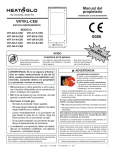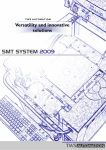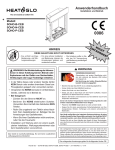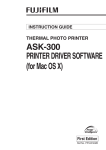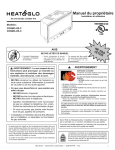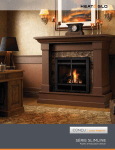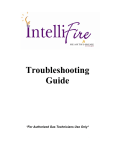Download Intellifire Plus troubleshooting guide intl revising ccc
Transcript
Troubleshooting Guide Australian Edition IntelliFire Plus Ignition System *For Authorized Gas Technicians and Service Only 11/30/2010 Hearth & Home Technologies © Page1 IntelliFire Plus Troubleshooting Guide Table of Contents Introduction…………………………………………………………………. 3-4 Tools and Instruments……………………………………………………... 5 System Basics……………………………………………………………… 6-11 Problem Scenario #1………………………………………………………. 12-17 Problem: Pilot wont’ light, no noise and no spark Problem Scenario #2………………………………………………………. 18 Problem: The module makes noise, but no spark Problem Scenario #3………………………………………………………. 19 Problem: Pilot sparks, but pilot will not light. Problem Scenario #4………………………………………………………. 20 Problem: Pilot lights, but continues to spark and main burner will not ignite. Problem Scenario #5………………………………………………………. 20 Problem: Pilot lights, stops sparking, and pilot remains lit. Burner will not light Diagnostic Codes………………………………………………………….. 21 System Checklist ………………..………………………………………… 22 Frequently Asked Questions (later edition)………………………… 23 Unit Orifice and Shutter Reference Pertinent Facts of Control System 24 25-26 11/30/2010 ………………………… Hearth & Home Technologies © Page2 Introduction IntelliFire Plus Troubleshooting Use of this Guide This troubleshooting guide provides an overview of the IntelliFire Plus system, reviews problem scenarios, provides a system’s checklist and frequently asked questions. The purpose of this guides is to provide a tool: • • • • To educate To aid in proper diagnosis for accurate parts replacement To reduce multiple service calls To gather necessary information to assist with proper diagnosis of problems Qualified Service Technicians Only This troubleshooting guide is for use by qualified service technicians only. It is designed to help qualified service technicians troubleshoot gas fireplace with IntelliFire Plus ignition systems. Warning: Do not attempt to service appliances which you are not qualified to service. Service attempted by unqualified persons could result in risk of bodily injury and property damage. Obligation of Service Professionals Service technicians must be attentive to appropriate codes, understand and follow manufacturer’s installation instructions, and use the proper parts and materials when servicing and installing gas appliances. One of the most important tools you bring to a service call is the installation manual. Communicating with the Owner Ask the owner a few simple questions prior to service: • • • • • • Has What are the symptoms? When does the problem occur? How long has the appliance been installed? Model Number Serial Number Operating Gas—P, N or B 11/30/2010 Hearth & Home Technologies © Page3 Introduction IntelliFire Plus Troubleshooting Technical Assistance—Distributors & Dealers Be prepared to provide the following information when contacting Hearth and Home Technologies: • • • Fireplace model and serial number Previous service history if with previous HHT reference number, if any Detailed problem description Technical Service will assign a reference number to troubleshooting calls when information is provided. To ensure a more timely repair and processing of claims involving multiple service calls, HHT expects a dealer to contact Technical Service after 2 failed attempts to repair a product. A completed checklist may be requested to assist with diagnosis. 11/30/2010 Hearth & Home Technologies © Page4 Tools and Instruments IntelliFire Plus Troubleshooting You will need the following tools and equipment to execute troubleshooting outlined in this guide. Required Tools: Required Testing Equipment: • Open end wrenchs, 3/8”, 7/16”, 9/16” • Multi-meter (must measure millivolts) • Adjustable end wrenches: 8” and 10” • Manometer • 1/4”, 5/16” nut driver • Leak detection fluid • Straight screwdrivers (including small 1/8” blade for pressure check and stubby straight. • 2 to 4, “300 mm—350 mm” jumper wires • “flame stick” lighter wand • Phillips screwdrivers #1 and #2 and stubby Phillips • Plastic straight screwdriver (Rhino style) • Electrical pliers • Needle nose pliers • Flashlight • Numbered drill index • T-20 tamper resistant Torx bit HHT part #810-225 • Soft-bristle toothbrush • Soft 1” paint brush • Electric drill 1/4” - 3/8” 11/30/2010 Miscellaneous: • Smoke Match • Drop Cloth/Tarp • Glass cleaner/towels • Vacuum • • Personal Protection Equipment Gas leak detector ALL TOOLS AND TEST EQUIPMENT SHOULD BE PROPERLY STORED AND MAINTAINED. Hearth & Home Technologies © Page5 System Basics IntelliFire Plus Troubleshooting The IntelliFire Plus IPI (intermittent pilot ignition) Ignition System and Wireless Controls is a total control system, from the components under the fireplace to the remote control in your hand. HHT Hearthville offers Sales and Product Knowledge Training modules as companions to this troubleshooting guide. Taking Hearthville modules is recommended. Ignition Control Components • • • • • • • Ignition Control Box 8k1-CE 240V to 6 DC Volt DC regulator power adapter Wiring Harness IPI Valve with Stepper Motor (or Single rate fixed with XLR) IPI pilot assembly Battery Backup (C battery, unit specific) Aux300CE auxiliary component box Wireless Controls* • • • RC300 AU wireless controls w/ batteries Wall Mounted Docking Station RC100 wireless wall switch * This guide assumes the wireless controls and battery backup components have been eliminated from the system for purposes of troubleshooting the ignition system. 11/30/2010 Hearth & Home Technologies © Page6 System Basics IntelliFire Plus Troubleshooting Eliminate wireless controls from the system when troubleshooting system. #2 #4 #3 #1 #2 ON/OFF/REMOTE switch on module must be in REMOTE position for wireless controls to operate the remote and optional wired wall switch. The wireless control and receiver (housed in the control module) communicate to and from each component via radio frequency. They must remain within 30 feet of each other. For the RC300 (AU), when in thermostat mode, transmission of information happens every 60 seconds. For optimum operation you may need to try different locations for the wireless control. #3 If a wired wall switch is installed and in the ON position, it will override the commands of the wireless controls. Must be OFF to use remote. User can still operate auxiliary functions (Heat Zone). 11/30/2010 #1 #4 AUX300CE module controls the FAN and incorporates timer and rheostat functionality. AUX300CE module also controls 2 auxiliary functions.: AUX1 offers high/med/low settings AUX2 offers ON/OFF control. Hearth & Home Technologies © Page7 System Basics IntelliFire Plus Troubleshooting IPI Ignition Control Module (see labeled diagram below) w/ remote receiver 1—Igniter sparks when commanded via wall switch, wireless control or control module switch to turn on main burner. Voltage through the wire to igniter on pilot assembly creates spark to ignite gas released to pilot assembly. 2—Sensor rod acknowledges pilot flame is present before releasing gas to the main burner for ignition. When a pilot flame engulfs the sensor rod it conducts electrical current from the sensor through the flame to ground in one direction, which acts as a switch to the control module at this connection. Gas flows to the main burner 4-8 seconds after continuity happens via flame rectification. 3—Sends commands from the wireless controls to the AUX modules, controlling fan kits (AUX module) and 2 additional auxiliary functions. 4—Fuel setting is factory set, but must be adjusted if fireplace is converted. Switch does not regulate gas pressure to valve, but it does allow for appropriate variability settings for flame modulation. Take care when adjusting this switch. We recommend using a small, straight ceramic/anti-static screwdriver, which is supplied by electrical supply companies. 5—Learn Button is used to program up to 3 wireless controls to fireplace. Instructions provided in controls instructions. 6—Diagnostic light assists with troubleshooting. Error code chart provided later in this guide. 7—ON/OFF/REMOTE Switch Ignition Control Connections and Functions 8—Power from battery pack, wall switch connection, and connection to valve pilot and burner regulators. 10 1 9—Flame Modulation (stepper motor) connection 10—Power supply connection. 6 volt regulated DC from power regulator. Plugged in to junction box. 2 7 9 8 3 6 5 4 WARNING: DO NOT CONNECT 240 V AC LINE VOLTAGE TO CONTROL MODULE. 11/30/2010 Hearth & Home Technologies © Page8 System Basics IntelliFire Plus Troubleshooting IPI Gas Valve w/ Stepper Motor 1. Pilot Regulator 2. Inlet Pressure Tap 3.Manifold Pressure Tap 4. Stepper Motor 5. Main Burner Regulator 1. Pilot regulator is stamped as Nat or LP, designating the factory setting. If converted the main burner regulator has fuel type stamped along the side, indicating the conversion. The orange wire from the ipi ignition module is connected to the pilot regulator. 2. Test the inlet pressure at this tap. 3. Test the manifold pressure at this tap. 4. The stepper motor is not a replaceable as a separate part, only available assembled to the main burner regulator. It’s function is to modulate the flame. There is no reliable field voltage test for the stepper motor. Valve will function without functioning stepper motor, but flame will not modulate. *** Note: An audible noise will be heard when the stepper motor is modulating flame during flame adjustment, in thermostat mode and when flame is turned off.*** Important gas supply information provided in HHT gas fireplace Owner’s Manual, Installation and Operation. A gas supply regulator must be installed in line with the gas supply to the valve if pressure supply line is above 3.7 kPa. If not, the diaphragm in the valve will start to pulsate. Normal operating pressures: Inlet: 1.13 kPa for natural gas 2.75 kPa for propane/butane gas Manifold: .8 kPa for natural gas 2.4 kPa for propane/butane gas 5. Main burner regulator is changed when unit is converted and comes with stepper motor installed. The green wire from the ignition module is connected to the main burner regulator. 11/30/2010 Hearth & Home Technologies © Page9 System Part Numbers IntelliFire Plus Troubleshooting Part Name Part Number IPI Plus Valves Variable N (30%) 2166-302 Variable P (30%) 2166-303 Fixed NG (XLR only) 2166-308 B&P Fixed (XLR only) 2166-309 Valve Regulator Assembly Variable N NGK-DXV-50 Variable P LPK-DXV-50 Fixed N (XLR only) NGK-DXF-NP Fixed P (XLR only) LPK-DXF-NP Pilot Assembly Natural 2198-012 Propane / Butane 2198-013 Natural (XLR only) 2090-012 Propane/ Butane (XLR only) 2090-013 IPI Plus Controls Components Remote Control Australia (No standby pilot) REM300-HNG-AU Aux300CE (auxiliary box) 2166-340 Control Module (Gray) 2166-306 Jumper wire GFK-240V fan to Aux300CE 2166-375 Battery Backup (C batteries) 4067-223 Wiring Harness 2166-304 DC power voltage regulator 2166-369 DC power voltage regulator (Soho and Vrtkl) (2 prong flat spade) 2166-305 Junction power box 2078-027 Junction power cord (Soho and Vrtkl) 2222-374 Jumper wire for Heat Zone connect to Aux box 2166-191 * Refer to current service parts list for most accurate information. 11/30/2010 Hearth & Home Technologies © Page10 System Part Numbers RC100 control IntelliFire Plus Troubleshooting Main Components of Wireless Controls RC100—Wireless wall mounted control. On/off capability only. RC300AU– Handheld remote control with wall mount holder. Thermostat, timer, Aux 1, Aux 2, and blower control. See instructions on RC300AU and RC100 for programming and function control. RC300AU Remote Control AUX300CE 2166-340 The Aux300CE is not needed for remote control operation, but it is needed for blower connection and control of the blower through the gray module. The remote interfaces with the gray module which controls functions on the Aux300CE. 11/30/2010 Hearth & Home Technologies © Page11 System Checklist IntelliFire Plus Troubleshooting Troubleshooting Checklist: Going into a service call with a conclusion prior to checking the complete system can lead to replacing unnecessary parts, multiple service calls and wasted time and money for you and the customer. When servicing any Heat & Glo product, the root cause of the problem should be identified. This will lead to confidence and ease of diagnosing problems in future service calls. Using the troubleshooting checklist to assist in your service call. This will… • Enhance consumer confidence • Provide consistent service performance • Provides unit history for future service calls • Improves communication when seeking technical assistance Checklist: • • • • • Visual Inspection for proper installation and condition of installation Does the vent configuration comply with approved venting diagrams for the unit? - Proper vent cap and clearances - Proper rise to run ratio of venting - All flue components connected and secured Electrical supply and components - Proper position of On/off switches - Isolation switch installed and ON - Remote control batteries are good - Power to junction box and earthed - Power to Ignition module - Module switch is in the “Remote” position - No wires are compromised and all connections secure and made - Wire harness from module to valve - Wire harness from Aux to module - Pilot wires to proper module terminals I and S - Green and orange leads from module harness to valve - Ground wire secure Gas Supply - Gas shutoff is in ON position - Assure proper gas sizing of line. How many appliance are operating on line? - Meets standards of AS5601 plumbing code Documentation -Serial number -Problem and resolution and how determined -Parts kept for return to dealer with paper work 11/30/2010 Hearth & Home Technologies © Page12 IntelliFire Plus Troubleshooting Problem: Pilot wont’ light, no noise and no spark* • Possible reasons: 1. Control Module selector switch NOT set properly. 2. Loose or improper wiring. System not grounded 3. No power to or from junction box 4. No power from 6Volt DC transformer 5. Wired wall switch not wired properly. 6. LP/NG switch on module damaged or not fully engaged into LP or NG setting. 7. Continuity issue. Spark gap or object interference. 8. Faulty module ** Notice ** Disconnect power to the system prior to disconnecting any components by switching the ON/OFF/REMOTE module switch to the OFF position. • It is not recommended to operate the ignition control module with disconnected wire connections. A short could cause permanent damage. • Introducing the pilot sensor rod with a false flame, such as from a flame stick, will cause the module to go into lock-out mode. This is due to a safety feature built in to the module. 1 Control Module selector switch NOT set properly. The module must be in the ON or REMOTE setting for unit to operate. Isolate remote from system when troubleshooting. Switch module to ON to test operation of unit. 2 Loose or improper wiring. System not grounded. Verify all wire connections. Verify that the ground wire, igniter wire, and sensor wire are all in tact and have continuity. A pinch or splice in the wires can cause a short to the system or a break in continuity and cause the module to go immediately in to lock-out mode. * Troubleshooting assumes the wireless controls & battery backup have been eliminated from the system. 11/30/2010 Hearth & Home Technologies © Page13 Problem Scenarios #1 continued... IntelliFire Plus Troubleshooting Problem: Pilot wont’ light, no noise and no spark * 3 No power to junction box or from junction box. If there is no power from junction box, trace electrical supply to junction box including proper wiring at junction box. 2 1 3 4 1. Assure power cord is attached within the junction box. 2. Verify black leads are connected . These are unused in new IPI plus system. 3. Check voltage by connecting voltage tester to Brown (hot) and Blue (neutral). Reading should be 220-240V. No power from 6Volt DC transformer If the module does not flash, trace power supply to junction box, from junction box and from 6 Volt transformer. Pulling and re-connecting the power supply cord from transformer does not serve as the same test as turning switch from OFF to ON. The DC regulator converts 220/240 volts AC to 6 volts DC. Check to assure that your electrical meter is set to measure DC. If you get a minimum of 6 volts DC from adapter, the adapter is good. * Troubleshooting assumes the wireless controls & battery backup have been eliminated from the system. 11/30/2010 Hearth & Home Technologies © Page14 Problem Scenarios #1 continued... IntelliFire Plus Troubleshooting Problem: Pilot wont’ light, no noise and no spark * 5 Wired wall switch not wired properly. The wiring to the wall switch may not be correct if fireplace does not turn on when the switch on the module is in the REMOTE position. AND….the optional wired wall switch is in the ON position. Red and Brown wire connect to wall switch. Diagram to the right reviews proper switch operation when wired wall switch and wireless controls are both installed. NOTICE: In the instance where the fireplace is off because it has been set with the RC300 to operate in thermostat mode and the fireplace is turned on with the wall switch, the fireplace will turn on. However, when the remote attempts to signal a command to shut off the fireplace because it has reached the thermostat set point, the fireplace will shut the unit off and go in to lock-out mode. This is rare, but to avoid, assure remote is out of thermostat mode before turning fireplace on with wall switch. Disconnect wall switch wires and turn on unit with the sliding switch on top of the module. If unit lights with module, then verify wall switch connections. 6 If the NG/LP selector switch is not turned completely to NG or LP setting, the fireplace will not ignite and will go into lockout mode. If the selector switch spins freely and does not engage into NG or LP position the switch is damaged and the module go into lockout module. Damaged switch requires module replacement. * Troubleshooting assumes the wireless controls & battery backup have been eliminated from the system. 11/30/2010 Hearth & Home Technologies © Page15 Problem Scenarios #1 continued... IntelliFire Plus Troubleshooting Problem: Pilot wont’ light, no noise and no spark * 7 Continuity issue. Spark gap or object interference. Check to assure pilot spark lead and sensor rod are intact. Verify that neither the sensor or igniter rod are contacting the pilot hood assembly. Assure that ceramic insulator of sensor rod is not cracked or broken. Test for Continuity of the system as shown. Make connections as shown and set meter for Ohms setting. If there is BAD reading, check wiring of system. If all wiring is intact, replace pilot assembly and retest for continuity. 8 Make sure that there is no media or excess carbon build up on sensor lead. This can cause a “false” sense situation and put the module in to lock-out. Remove any debris or objects that are in contact .with the sensor or spark leads. Faulty Module 2 red flashes does not designate the module as bad, it states that there is insufficient voltage from the ignition coil to pilot flame igniter. Verify system voltages from module before replacing module. * Troubleshooting assumes the wireless controls & battery backup have been eliminated from the system. 11/30/2010 Hearth & Home Technologies © Page16 Check voltage from module to valve PILOT solenoid. Pull back wire shield of orange wire and connect red meter probe to orange lead of valve. Connect black meter probe to valve body as shown. Turn system on to start lighting sequence. There should be 1.2 volts to 3 volts running through orange lead from module. If there is not, then the module is bad or the wiring harness is compromised. Replace wiring harness and then module. If the pilot lights but the burner will not, check voltage from module to MAIN VALVE solenoid. Pull back wire shield of green wire and connect red meter probe to green lead of valve. Connect black meter probe to valve body as shown. Turn system on to start lighting sequence. There should be 1.2 volts to 3 volts running through orange lead from module. If there is not, then the module is bad or the wiring harness is compromised. Replace wiring harness and then module. 11/30/2010 Hearth & Home Technologies © Page17 Problem Scenarios #2 IntelliFire Plus Troubleshooting Problem: The module makes sparking noise, but no spark * ** Reference prior troubleshooting steps: 2 Loose or improper wiring. Check that igniter is not disconnected, loose, or shorted to fireplace. 7 Continuity or earth issue. Spark gap. There should be about a 3 mm (1/8”) gap from igniter to pilot hood. Verify sensor lead wire. ** Notice ** • Disconnect power to the system prior to disconnecting any components by switching the ON/OFF/ REMOTE module switch to the OFF position. • It is not recommended to operate the ignition control module with disconnected wire connections. A short could cause permanent damage. • Introducing the pilot sensor rod with a false flame, such as from a flame stick, will cause the module to go into lock-out mode. This is due to a safety feature of module. If there is no pilot light after 60 seconds or igniter is shorted and attempts to light for 60 seconds, then the module will go in to lock-out. It will flash green 3 times and go into lockout. Voltage shorted to ground may cause damage to module, resulting in damaged module. Additional: 9 Verify gas flow to valve and air bled out of line. Also assure proper appliance gas line sizing. Pressure loss occurs when too many appliances are on one gas line, gas line undersized, or distance from meter to appliance is excessive. If there is a sputtering sound and intermittent pilot lighting, the gas line may be undersized or there is air in the gas line. Again, the module will lock-out after 60 seconds of no lighting. Reset module. Verify that there is a gas regulator installed before the valve for any gas supply that exceeds 3.7 kPa. At pressures above this, the valve will start to pulsate. Proper inlet and manifold gas pressures are in each gas appliance manual. Reference Australian Plumbers Code AS5601 for additional codes and regulations. Verify that the appliance gas shut off valve and any other appliance shut off valves are on. 11/30/2010 Hearth & Home Technologies © Page18 * Troubleshooting assumes the wireless controls & battery backup have been eliminated from Problem Scenarios #3 IntelliFire Plus Troubleshooting Problem: Pilot sparks, but pilot will not light. Reference prior troubleshooting steps: 9 Gas supply 8 Faulty module 10 Faulty valve Check voltage from module to valve PILOT solenoid. Pull back wire shield of orange wire and connect red meter probe to orange lead of valve. Connect black meter probe to valve body as shown. Turn system on to start lighting sequence. There should be 1.2 volts to 3 volts running through orange lead from module. If there is appropriate voltage to orange solenoid of valve, then the valve is bad or the wiring harness is compromised. Replace The voltage reading will start at 1.2 volts for the first couple seconds and then drops voltage down to low setting. As long as start voltage is at least 1.2 volts and it maintains .3 volts to keep the valve open, then the pilot solenoid is good. If the pilot lights but the burner will not, check voltage from module to MAIN VALVE solenoid. Pull back wire shield of green wire and connect red meter probe to green lead of valve. Connect black meter probe to valve body as shown. Turn system on to start lighting sequence. There should be 1.2 volts to 3 volts running through orange lead from module. If there is appropriate voltage to green solenoid of valve, then the valve is bad or the wiring harness is compromised. Replace wiring harness and then module. The voltage reading will start at 1.6 volts for the first couple seconds and then drops voltage down to low setting. As long as start voltage is at least 1.6 volts and it maintains .3 volts to keep the valve open, then the main valve solenoid is good. 11/30/2010 Hearth & Home Technologies © Page19 * Troubleshooting assumes the wireless controls & battery backup have been eliminated from the system. Problem Scenarios #3 continued, #4, and #5 IntelliFire Plus Troubleshooting Problem: Pilot lights, but continues to spark and main burner will not ignite. Reference prior troubleshooting steps: 7 Continuity or earth issue. 9 Gas Supply. 2 Loose or improper wiring. 10 Faulty Valve. Problem: Pilot lights, stops sparking, and pilot remains lit. Burner will not light. Reference prior troubleshooting steps: 8 10 Faulty Module. Faulty Valve. 11/30/2010 Hearth & Home Technologies © Page20 * Troubleshooting assumes the wireless controls & battery backup have been eliminated from the system. Diagnostic Codes IntelliFire Plus Troubleshooting Diagnostic Codes are listed below and should be used as a additional tool to help diagnose failure modes. Use the troubleshooting guide to check all possible failures before changing any component parts. CODE 1 Flash 2 Flash RESPONSE ERROR CAUSE Module flashes error code and goes into lockout mode. Module flashes error code and goes into lockout mode. 1. Fuel-type selector in incorrect position 2. 2. Fuel-type selector switch damaged Insufficient voltage from ignition coil to pilot flame igniter ERROR RESOLUTION 1. Verify that the selector stops at the correct position when rotated gently with a precision screwdriver Clear Lock-Out and attempt ignition. If condition persists, replace module 1. Verify proper inlet pressure to the gas line 3 Flash Pilot sparks and may ignite for up to 60 secs, but main will not open. If condition occurs for =/> 60 sec, module flashes error code, shuts down pilot, and goes into lockout mode 1. Inadequate gas supply 2. False flame detected 3. Short in sense lead 4. Sense and/or igniter lead disconnected 2. Verify that pilot leads are correctly terminated to the control module, and that no shorted wires exist. 3. Verify that the pilot sense rod, igniter rod, and hood are clean. Error Code is not constant. It must be caught immediately or duplicated by testing the appliance and watching the module for the instant error code. 11/30/2010 Hearth & Home Technologies © Page21 System Checklist IntelliFire Plus Troubleshooting Visual Inspection Make as many pertinent notes to the installation as possible. This will aid significantly in troubleshooting and diagnosing any future instances. 11/30/2010 Hearth & Home Technologies © Page22 Frequently Asked Questions IntelliFire Plus Troubleshooting Ignition Control Module with control receiver Q: What is the high to low turndown for the Intellifire Plus system? A: The modules have the capability of regulating the gas pressure to the main burner with the manual High/Low switch. This allows the flame variability without the use of a wireless control. 2166-340 has a 30% turndown. Q: If the fireplace is on and being operated via a wireless control, power is lost and there are batteries in the battery backup carriage do I need to switch the ON/OFF/REMOTE switch on the control module to ON? A: As long as the batteries in the carriage have voltage the fireplace will seamlessly revert to the power from the batteries to power the operation. Fresh batteries will keep fireplace running up to 72 hours. Q: Why is there an NG and LP switch on the module? A: This allows a slight software alignment for control to the valve for the different fuel. Q: Why do you need to disconnect power to system prior to disconnecting any components? A: If the stepper motor has a disruption of power it will be stuck in the last position prior to lose of power. Properly disconnecting power will set a sequence to the stepper motor to start on high once powered again. Q: Why is it not possible to field test the stepper motor? A: There a 2 reasons. The pin connectors from the wiring harness to the module are very small and difficult to connect to multi-meter test probes. Complicated voltage sequence. Q: Why does the unit make an unusual clicking noise when changing flame setting? A: This is an audible response that the valve is changing flame height. There are 6 flame height settings and it is not always easy to distinguish the change in height. Q: Why is there a fuse in the battery backup? A To meet CE and AGA requirements there must be a fail safe for surge or interrupt. Q: Are the Intellifire and Intellifire Plus components interchangeable. A: No. 11/30/2010 Hearth & Home Technologies © Page23 Unit Orifice and Shutter Setting Reference Max Heat (MJ/h) Orifice DMS Orifice Metric(mm) Shutter Setting 21 #44 2.18 9.5 mm 350TRSILP-AUF 19.8 #55 1.32 11 mm 350TRSILP-AUF (Butane) 17.2 #56 1.18 12.5 mm 550TRSI-AUF 28 #40 2.49 11 mm 550TRSILP-AUF 26 #.057 1.450 Full Open 550TRSILP-AUF (Butane) 20 #55 1.32 Full Open 6TRSI-AUD 36 #33 2.87 12.5 6TRSILP-AUD 34 #51 1.70 Full Open 6TRSILP-AUD (Butane) 29.5 #53 1.51 Full Open SOHO-N-AUB 14.4 #50 1.78 11 mm VRT-N-xx-AUB 26.7 #39 2.53 13 mm VRT-P-xx-AUB 24.5 #.057 1.45 11 mm XLR-N-AU 26 #42 2.35 2 mm XLR-PB-AU 26 #.057 1.45 8 mm XLR-PB-AU (Butane) 22 #55 1.325 Full Open XLR-N-AU (Logs) 26 #42 2.35 5 mm XLR-P-AU (Logs) 26 #.057 1.45 11 mm XLR-PB-AU (Logs) (Butane) 22 #55 1.325 Full Open ST-HVBI-AUB 44 #30 3.26 13 mm 42.5 #49 1.85 Full open UNIT 350TRSI-AUF ST-HVBILP-AUB GRL-850-AU 60 1.55 (7-hole) 9.5 mm GRL-850LP-AU 60 2.33 Full Open 11/30/2010 Hearth & Home Technologies © Page24 IPI Plus Noteworthy IntelliFire Plus Troubleshooting System will always light on high flame when turned on. Wall switch will always override remote. Wall switch needs to be off for remote operation. There is a 10 second delay before any flame adjustment can be made. Once a remote has been programmed, there is no longer flame adjustment at module. A module can be de-programmed by pressing the learn button of module and intentionally not depressing a button on the remote receiver within the learn time. 5 second child lock on remote. The power button must be depressed for 5 seconds toe “enable” the remote. This is a requirement of the testing and agency approval for multi-functional controls. After you turn the fireplace off, the stepper motor will default back to the high flame position, then once the fireplace is turned back on it will light on high but after the 10 second delay it will resume the flame height position it was set to when turned off . Basically, always lights on high but will remember where you left it set to, and will return to that setting. Aux 1 or 2 functions can be run at any time, with or without fire on, and there is no delay. There are 3 settings for Aux 1 and On/off control for Aux 2. The system will also remember what setting these were set to and will resume that setting when turned on each time. Heat zone can be connected to either. The blower speed can be set at any time after turning fireplace on. However, there is a built in delay of 7 minutes from start up until it comes on, and also a 12 minute delay in which the blower will run after the fireplace is turned off. These settings were implemented to replicate the blower temp sensor disc that used to command the blower on and off according to firebox temperature. There is a lock out mode. If pilot fails to light after a 60 second attempt , the module will go in to a lock out mode and will require a manual reset. No functions will work while in a lock out mode. The light on the module will signify the lock out status. It will be flashing, 2 flashes, one red and then one green. The module can be reset by sliding the switch on the top of module to the “off” position and them back to “remote”. The “on” position on top of the module will run the system if no remote or wall switch is installed. By sliding the switch to “on” the pilot and then the burner will light. A flame adjustment can also be made from the module using the “high/low” sliding switch. However, if a remote has already been programmed in to the system, this flame high/low switch becomes disabled. If a remote has not been programmed in, the switch will change the flame height setting (only from max height to min low) but after the 10 second delay. The stepper motor will still function on battery back up and full flame adjustment can be made from the remote or using the high/low sliding switch on module. There will still be a 10 second delay before any flame height adjustments can be made. Aux 1 an Aux 2 will not function in battery mode. Blower will not function on battery back up mode. It is safe to leave batteries in the battery holder even when operating on normal current from junction box, the batteries will not be drained nor will the system attempt to charge them. CR2032 batteries for RC100 11/30/2010 Hearth & Home Technologies © Page25 If a wall switch hass been installed it will override the remote. You will want to leave the wall switch in the off position if remote operation is desired. There is a safe auto shut down built in to the control module for the instance where there has been 9 hours of uninterrupted continuous operation of the appliance. This is not a function of the remote. If using the wall switch—or the remote in the full time “on” mode, unit will only run for 9 hours continuously. (verify the remote control thermostat function and possible bypass). The remote and thermostat mode will still operate in battery back up mode. No accessory functions will operate off of the battery back up. 11/30/2010 Hearth & Home Technologies © Page26 Technical Service Contacts and Information Website: www.heatnglo.com or fireplaces.com Toll free number: Technical Service Email: How to access most recent revision manuals: 11/30/2010 Hearth & Home Technologies © Page27





























